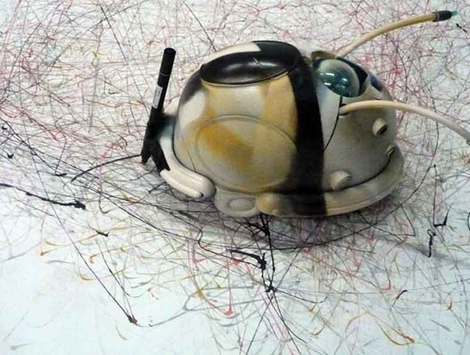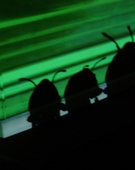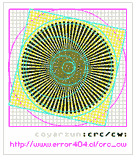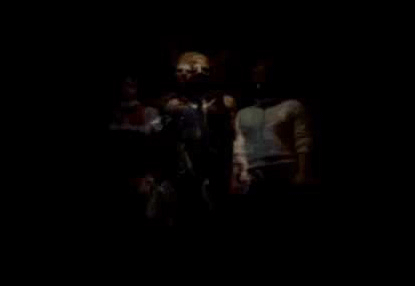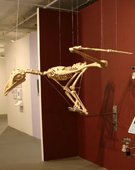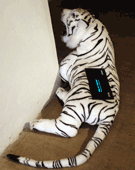Twelve robots - each named after prison inmate numbers – roam freely on a canvas on the floor of the Gallery. These robotic prisoners are sent out across the canvas with small tasks to complete. This robotic “wandering” is captured over the evening onto the canvas. They create their own painting in their own little prison.
Full Description
The robots wander over the canvas to make the image - and this also protects the floor. The suggested canvas size 2.5 by 5m - and therefore a reasonable floor space is needed. All the robots will see the edges of the canvas and turn around automatically) i.e. they are roped off and will not go wandering off on their own! The set up is easy.
There was also a CCTV set up; with wireless cameras on each robots so they could keep an eye on one another and we could watch them on the TV.
I now have a series of fifteen very large canvases (4 by 3 metres approx) made by the robots. They are available all for sale and for exhibition. The robots and canvases are available for touring.
Work metadata
- Year Created: 2008
- Submitted to ArtBase: Saturday Sep 22nd, 2012
- Original Url: http://www.stanza.co.uk/panopt/index.html
-
Work Credits:
- stanza, primary creator
Take full advantage of the ArtBase by Becoming a Member
Artist Statement
The idea of the Panopticon originated with the English utilitarian philosopher Jeremy Bentham as a prison design that would allow an observer to monitor all the prisoners at all times, without any prisoner being aware of whether he was being monitored or not. Like people, robots have common behaviours and can be programmed accordingly i.e. robots can follow a path (path following mode), the can avoid obstacles (avoidance mode) and they can operate in wander mode. They all try to avoid one another - depending on their proximity to one another - while searching the space. In doing so they demonstrate social behaviour. In moving through the gallery people create a ‘memory space’- a reference to a past created by the traces and paths left behind. The patterns we make, the forces we weave, reveal different ways of moving through the space. These patterns disclose new ways of seeing the world. All the robots are recorded via CCTV and each is made to wear CCTV which is shown on a monitor which also records the event. Police “tape” keeps the robots inside their controlled space.
Robot by stanza. v
Robotica - IV: Control Inside The Panopticon
“Robotica: Control inside the panopticon” at The Victoroa And Albert Museum.
Exhibition By Stanza 2006 - 2008
A world premier of Stanza’s “Robotica: Control inside the panopticon” at The Victoria And Albert Museum, London. A playful robot installation - with performative and interactive aspects - that questions ideas of surveillance and tracking in popular culture using, robots, CCTV and sensor technologies.
Stanza Robotica: Control inside the panopticon About
Twelve robots - each named after prison inmate numbers – roam freely on a canvas on the floor of the Gallery. These robotic prisoners are sent out across the canvas with small tasks to complete. This robotic “wandering” is captured over the evening onto the canvas. They create their own painting in their own little prison.
The idea of the Panopticon originated with the English utilitarian philosopher Jeremy Bentham as a prison design that would allow an observer to monitor all the prisoners at all times, without any prisoner being aware of whether he was being monitored or not. Like people, robots have common behaviours and can be programmed accordingly i.e. robots can follow a path (path following mode), the can avoid obstacles (avoidance mode) and they can operate in wander mode. They all try to avoid one another - depending on their proximity to one another - while searching the space. In doing so they demonstrate social behaviour. In moving through the gallery people create a ‘memory space’- a reference to a past created by the traces and paths left behind. The patterns we make, the forces we weave, reveal different ways of moving through the space. These patterns disclose new ways of seeing the world. All the robots are recorded via CCTV and each is made to wear CCTV which is shown on a monitor which also records the event. Police “tape” keeps the robots inside their controlled space.
The robots mimic and trace the patterns people make - but based on algorithms. The robots are tracked - everything is watched and recorded - and unlike people their movements can be networked into retrievable data structures that it can be re-imagined and sourced for information. The digital patterns of the robots are re-made as analogue patterns. The robot path is in effect replaced with a series of 'brushes' - and it is these that are wandering around the canvas. A series of actions are applied to the movement of the digital brush across the rectangular canvas to create these robotic generative paintings. This artwork investigates the relationship between the analogue and the digital aesthetic.
A world premier of Stanza’s “Robotica: Control inside the panopticon” at The Victoria And Albert Museum, London. Exhibition
Installation
The robots wander over the canvas to make the image - and this also protects the floor. The suggested canvas size 2.5 by 5m - and therefore a reasonable floor space is needed. All the robots will see the edges of the canvas and turn around automatically) i.e. they are roped off and will not go wandering off on their own! The set up is easy.
There was also a CCTV set up; with wireless cameras on each robots so they could keep an eye on one another and we could watch them on the TV.
Paintings.
I now have a series of fifteen very large canvases (4 by 3 metres approx) made by the robots. They are available all for sale and for exhibition. The robots and canvases are available for touring.
“Robotica: Control inside the panopticon” at The Victoroa And Albert Museum.
Portrait Of St Paul. 100 by 80 cm C print signed Stanza. 2008
“Robotica: Control inside the panopticon” at The Victoroa And Albert Museum.
“Robotica: Control inside the panopticon” at The Victoroa And Albert Museum.
Keywords networked, generative, installation, artworks, robots, artworks, paintings, surveillance,
TechnologyGroup of fully programme self built robots wander around, programmed to avoid one another and to try to escape..
Film the robots in action. A playful robot installation A playful robot installation A playful robot installation A playful robot installation A playful robot installation A playful robot installation A playful robot installation
Stanza Painting made with robots
Exhibition Le Bains Numerique 4. in Paris June 2009 organised by B>D>S> nine large canvases produced over nine days......available for further exhibition.
Nine very large robot paintings are now available for further exhibition. Stanza Painting made with robots v Stanza_robot_paintings 031 Stanza_robot_paintings 049 Stanza Painting made with robots Stanza_robot_paintings 063 Stanza Painting made with robots Stanza Painting made with robots Stanza Painting made with robots Stanza_robot_paintings 082 Stanza Painting made with robots Stanza Painting made with robots Stanza Painting made with robots Stanza Painting made with robots Stanza_robot_paintings 095 Stanza_robot_paintings 105
Touring
Production set up as a attachment for curators.
Please note I have conceived of the next version but this will need funds and more production set up.
Image for press.
Disclaimer All rights reserved. The copyright for any material published on this website is reserved. Any duplication or use of objects such as images, diagrams and texts is not permitted without Stanza written agreement.
